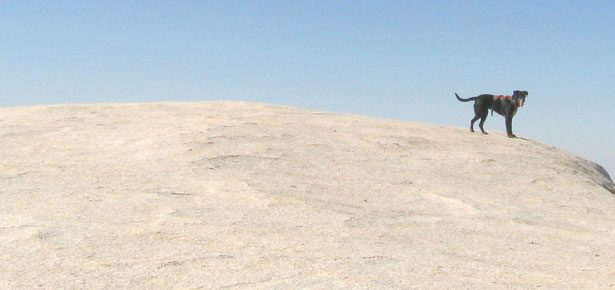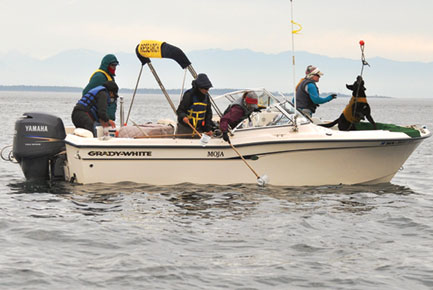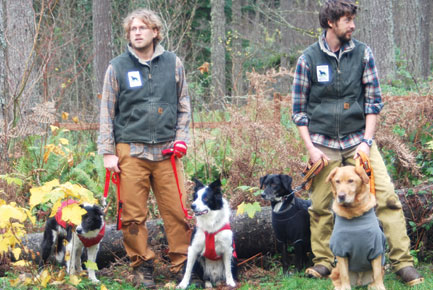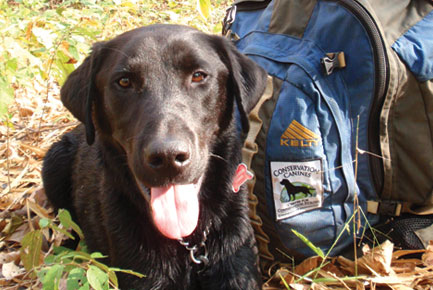

Go Find It
The Battle Cry of Conservation K9s
Max was down to his last chance. The high-energy Australian Cattle Dog/Blue Heeler mix was in a Washington shelter, likely destined for death row, until fate intervened and he was plucked from near oblivion by the Conservation K9s program at University of Washington.
Even at the program, which employs dogs to track and locate evidence of threatened wild animal populations, no one was absolutely sure he would succeed. But with a little faith and perseverance, Max finally achieved “back-up dog” status. Then, to his great fortune (and hers), he was paired with Jennifer Hartman, a field biologist and dog handler at UW’s Center for Conservation Biology.
Hartman had started working with some of the dogs at the Center and wondered if this line of work was really for her. Then she took Max out to play.
“It was so awesome. Working with Max was fun. I wasn’t getting frustrated. He was the first dog I was having fun with,” she says. Max and Hartman have since done full duty searching for Northern Spotted Owl in California. Max bypassed his back-up dog status and is now officially working as a Conservation K9, sniffing out fresh owl pellets to assist with conservation efforts.
Like all Conservation K9s, the dogs work with handlers in the field. Each dog is trained to sniff out feces which in turn are analyzed by scientists to determine the health, activity, and location of the particular species the dogs are tracking.
The Conservation K9 (CK9) program is the brainchild of Dr. Sam Wasser, Director of UW’s Center for Conservation Biology, which houses 17 dogs currently, but has room for 30. Many breeds can be CK9s, but most are retrievers, Labs, Border Collies, Australian Cattle Dogs, and, once, even a pair of Jack Russell Terriers. Large muscular dogs, perhaps surprisingly, don’t do well in the program as they tire more quickly.
Begun in 1997, the original premise was to prove the impact of human disturbance on wild animals.
“It’s rare that just one disturbance happens on a population; usually it’s many,” says Wasser, explaining that many factors work together to bring about peril to wildlife.
He uses the example of Orcas. There’s overfishing Chinook salmon. There are also toxins in the oceans, and the popular activity of whale watching means that sometimes, people get too close to Orcas. Climate change has its own effect. How these factors affect whales, and at what times of year, and during which activities, all work in conjunction to point scientists to ways to lessen the negative impact on wildlife. By examining the nutritional information, reproduction and stress hormones, and toxins all present in poop, scientists are able to determine which external factors at what times have the greatest impact.
“It’s really important, if we’re trying to resolve the problem, to figure out the impact of various pressures. The feces of an animal contain toxins and genetic information about their health and who they are,” says Dr Wasser. “There is no product more accessible than feces in wildlife.”
And no one can sniff out poop like a dog. Dogs, says Wasser, are an incredibly powerful tool.
CK9s are trained to find the droppings of a specific species, and are rewarded with play only when they are successful. Not just any dog can do this, says Wasser. A scat dog has an obsessive drive to play with a ball so extreme they often cannot be kept as pets.
“Those are exactly the kinds of dogs at the pound [we look for]—intense and unadoptable. We search for extremely high-drive dogs. All our dogs are rescued.”
Sadie May, a 10-year-old owner-surrender black Lab mix from Colorado, started her field work in the tar sands. Then, more exotic adventures called her.
“We left for Cambodia at the end of 2009 to sniff out tiger poop,” says Elizabeth Seely, conservation field biologist and dog handler. The task was to determine if the Mondulkiri Protected Forest, an ideal tiger habitat, was actually home to any.
Unfortunately, Seely and Sadie May were unsuccessful in providing proof of tigers living there, as Sadie May was unable to find the scatological evidence the team sought. “It was like looking for a needle in a haystack,” Seely says. Though Sadie May didn’t find any tiger poop, she did learn, after acclimatizing to the heat, to sleep three feet off the ground, suspended in a hammock with zipped-in mosquito netting.
In new environments, says Seely, trust between dog and handler is vital.
“We had a good bond. She is very trusting and so obsessed with the ball that she didn’t notice anything. Like snakes. A king cobra reared on us and I showed her the ball and she was out of there.”
Safety issues are a bigger deal for handlers than dogs, says Seely, and dogs adjust to new situations easier than humans. The dogs’ scat-finding training is so species-specific and is rewarded so satisfyingly—the ball again—that the dogs zone in on a specific scent while ignoring all others. For obvious reasons, dogs can’t be chasing after wildlife that moves or scares them, and this training saves lives.
Seely can attest to this first-hand. While lounging in their hammocks in smoke-filled air from burning wildfires, Seely suddenly heard a huge noise and remarked to a colleague that it sounded like a herd of elephants. Almost immediately, an actual herd of elephants came crashing through the trees. Sadie May started barking and, just like in cartoons, the elephants stopped dead in their tracks, then turned and ran away. Sadie May never left her hammock.
Seely also works with Tucker. Found on the streets, Tucker was taken to a North Seattle shelter where he was rescued by the CK9 program. The black Lab has spent the last seven years sniffing out Orca poop floating in the Pacific Ocean.
It’s tricky work. Orca poop disintegrates quickly and for the whales’ safety, boats maintain a distance of at least 400 metres. Tucker’s amazing nose can locate whale poop up to a mile away.
Tucker knows it’s work time the instant he gets into the truck for the drive to the boat, where he exits his crate, gets into his life jacket, and hears the command “go find it.” Tucker and Seely ride up front in the triangular bow of the boat, with Tucker firmly on a leash. Since whales swim in all directions, the boat concentrates on the direction of the wind, allowing the scent to cross Tucker’s nose.
“Tucker shows a change in his behaviour when he hits the scent cone. He turns his head in its direction and wags his tail. He becomes more animated and leans over the edge, shifting left or right depending on where the sample is strongest. He opens and closes his mouth and bobs as we get closer. Once we visualize it and the sample is out of the water, we pass it to Tucker’s nose first, then we play ball,” says Seely. The ball, she adds, is on a rope so if it goes off the edge, she can pull it back, because, ironically, Tucker is afraid of the water.
Heath Smith, conservation field biologist, is the trainer for the Center’s dogs. He says it takes about two months to train a dog, but only a day or so to train on a new scent.
“I tell the handlers the joy for the dog is finding the next scat and then getting the ball. It’s the excitement of ‘find and reward,’” says Smith. “To me, we’re partners on a treasure hunt. The dog needs boundaries but is better at understanding what I want than I am at understanding what they’re saying. It’s easy for a dog to train a handler. It’s a lot of practice to train a dog.”
Smith says after working in the program for so long, he is still sometimes surprised by what the dogs do.
Take Gator, for example. The Australian Cattle Dog came to the Center when he failed at drug-sniffing. As it turned out, Gator was fabulous at being a CK9. Trained to sniff out maned wolf poop, Gator and Smith headed for Brazil. Gator was ready for work, outfitted in his harness and bear bell for safety. As usual, he responded immediately to Smith’s command to “go find it.”
“He was at one spot high on a hill. I saw him and he was staying,” says Smith, explaining Gator would not move, no matter what, once he found a sample. “Then I see him scoot two feet over and stay. He did this over and over.”
Once Smith reached Gator, the mystery was solved. An army of leaf-cutter ants was carrying the wolf scat away, and Gator was simply following it.
But even with such extraordinary dogs, there are other things that are solid and predictable and, in their own way, a part of the journey one hopes not to miss.
Gator had reached the age of 15 and was living with Smith at the Center. Although Gator had been ill a year before, he had returned to work with Smith, seeking Grizzly Bears in Jasper. Then he got sick again. In the middle of one particular night, Gator came into Smith’s room. Smith bent over to pet him and Gator collapsed, dying right there at his best friend’s side.
“He was the closest friend I ever had. He went everywhere with me,” says Smith. “Gator was so loyal and amazing. He was the most amazing thing I ever met. I’m lucky I got to say goodbye.”
Conservation K9s, Rescuing Shelter Dogs and Putting Their Noses to Work for Wildlife Conservation Since 1997
The Conservation K9 program is a non-profit that struggles to maintain itself through the year, relying very heavily upon public donations to help cover the cost of maintaining the program when deployments are low. If you’re interested in making a donation in support of the program, you’ll find more info at conservationbiology.net/donate. For updates on the very cool work they’re doing, follow these loveable dogs and their handlers on Facebook (facebook.com/ConservationCanines) and Twitter (@conservationK9).
Join the newsletter and never miss out on dog content again!
"*" indicates required fields
By clicking the arrow, you agree to our web Terms of Use and Privacy & Cookie Policy. Easy unsubscribe links are provided in every email.


